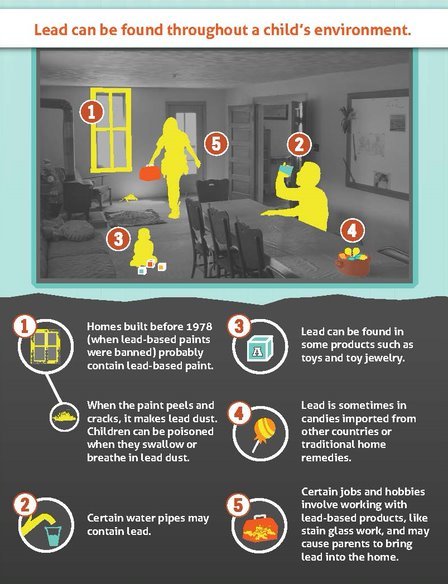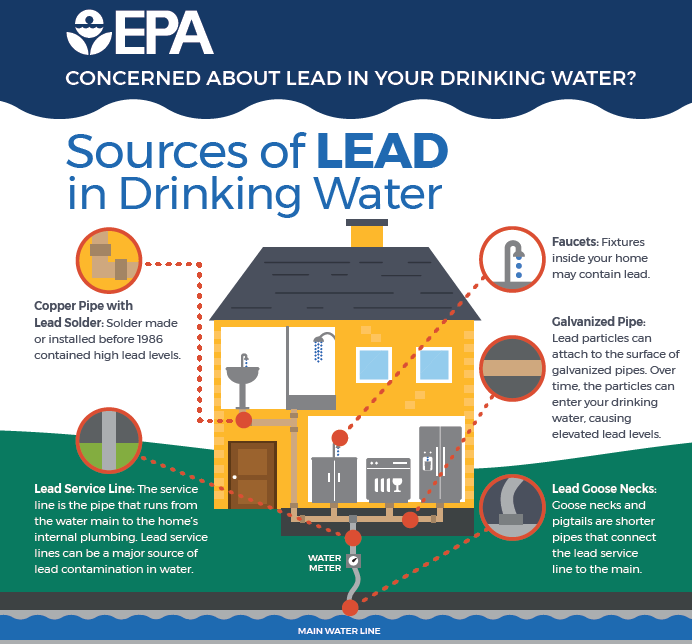Disclosure: This post contains affiliate links and I will be compensated if you make a purchase after clicking through my links. Learn More
Imagine turning on your tap, expecting a refreshing glass of water, but unknowingly, it could be tainted by the hidden dangers of lead pipes. If you own an older home or are considering buying one, the lurking presence of lead pipes is a risk you can’t afford to ignore.
Are you curious whether your charming old house might harbor this silent threat? Recognizing the signs of lead pipes is crucial for your health and safety. We’ll guide you through simple steps to identify these hazardous pipes, empowering you to make informed decisions for your home and family.
Don’t miss out on this essential information—your peace of mind might just depend on it.

Credit: www.epa.gov
Recognizing Lead Pipes
Lead pipes pose health risks in older homes. Identifying these pipes is crucial. Homeowners need to know the signs. This section helps you recognize lead pipes easily.
Visual Characteristics
Lead pipes have distinct visual traits. They often appear dull gray. Scratching with a coin reveals a shiny surface. These pipes are soft and easily bent. Check exposed pipes in your basement or under sinks. Lead pipes usually lack a threaded end. This is a clear indicator.
Age Of The Home
Homes built before the 1980s may have lead pipes. Older homes are at higher risk. Lead was commonly used in plumbing until then. If your home is older, inspect your plumbing system. Consider checking public records or home history. This may provide useful information. Contact a professional for a thorough inspection.
Health Risks Of Lead Pipes
Old homes may have lead pipes, posing health risks. Look for dull gray pipes with a metallic feel. Scratching reveals a shiny silver color, indicating lead. Water discoloration and plumbing issues can also signal lead presence. Addressing these signs ensures safer drinking water and healthier living conditions.
Lead pipes in old homes are more than just a relic of the past; they pose serious health risks to you and your family. While these pipes were once a popular choice due to their durability, we now know they can leach lead into your drinking water. This contamination can lead to a host of health issues, particularly in vulnerable populations like children and pregnant women. Understanding these risks is crucial for taking the necessary steps to protect your loved ones.
Impact On Children
Children are especially susceptible to the dangers of lead exposure. Even small amounts of lead can affect a child’s brain development, leading to reduced IQ, attention problems, and academic struggles. It’s heart-wrenching to think a simple drink of water could impact your child’s future.
Have you ever noticed behavioral changes in your child that seemed sudden or unexplained? Lead exposure could be a silent factor. Often, the symptoms can be subtle and easily attributed to other causes, making it crucial to consider the possibility of lead in your home’s water supply.
Long-term Health Effects
The consequences of lead exposure don’t stop at childhood. Adults exposed to lead over time can face serious health challenges. High blood pressure, kidney damage, and reproductive issues are just a few of the potential long-term effects. Imagine facing health problems that seem to have no clear origin. It might be worth considering the water pipes in your home as a potential culprit. This isn’t just about immediate health—it’s about your quality of life in the years to come.
Lead exposure symptoms can be deceivingly common, like fatigue or irritability, making it easy to overlook the root cause. By identifying and addressing lead pipes in your home, you could prevent these health issues before they begin. Isn’t it worth the peace of mind to ensure your home is a safe haven for everyone living in it?
Testing For Lead
Old homes may have lead pipes, indicated by dull gray color and easily scratched surfaces. Water with a metallic taste or plumbing over 50 years old also suggests lead presence. Testing is crucial to ensure safety.
Testing for lead in your home is crucial, especially if it’s an older property. Many homes built before the 1980s might have lead pipes, which pose significant health risks. Knowing how to test for lead can safeguard your family’s health and ensure your peace of mind. But how do you know if your water is safe? Let’s dive into some effective methods for testing lead in your home.
Water Testing Methods
Testing your water is a straightforward way to check for lead contamination. Start with a simple at-home water testing kit. These kits are available online or at local hardware stores and usually come with easy-to-follow instructions. They provide a quick snapshot of your water’s condition.
If you prefer a more comprehensive analysis, consider sending a water sample to a certified laboratory. Labs can test for lead and other contaminants, giving you a detailed report of your water quality. This method might take a bit longer, but it offers a thorough examination.
Have you ever wondered if the water you drink every day is safe? Testing can answer that, providing peace of mind with just a few simple steps.
Professional Inspections
Engaging a professional inspector can be a wise choice if you suspect lead pipes. Professionals use specialized equipment to detect lead presence that might not be apparent to the naked eye. They assess not just the water but also the physical condition of your pipes.
During an inspection, experts examine plumbing materials and connections. They look for telltale signs of wear or corrosion that could indicate lead leaching into your water supply. This thorough check can identify issues that a simple water test might miss.
Have you ever thought about having a professional take a look at your pipes? It might be the best decision to ensure your family’s safety and catch potential problems early.

Credit: www.nrdc.org
Identifying Warning Signs
Lead pipes can pose significant health risks. Identifying warning signs is crucial. Homeowners must be aware of changes in water quality. Discolored water and unusual taste or smell are common indicators. These signs can suggest the presence of lead pipes in old homes.
Discolored Water
Discolored water is often a major warning sign. It may appear yellow, brown, or cloudy. This can indicate lead or other contaminants. Check for discoloration in your tap water. It’s important to notice persistent changes. Discolored water can affect your health over time.
Unusual Taste Or Smell
An unusual taste or smell in water may signal a problem. Lead pipes can cause metallic or bitter tastes. Water might smell musty or earthy. These changes can be subtle but significant. Trust your senses and investigate further. Consistent unusual taste or smell should be a concern.
Local Regulations And Support
Lead pipes in old homes pose serious health risks. Understanding local regulations and support can help homeowners address these issues. This section explores the available government initiatives and community resources.
Government Initiatives
Governments offer programs to tackle lead pipe problems. Many local governments provide grants and low-interest loans. These funds assist homeowners in replacing old lead pipes. Some areas have set regulations for lead pipe removal.
Homeowners must comply with these rules to ensure safety. Municipalities often conduct lead testing in older neighborhoods. They aim to identify and mitigate risks quickly.
Community Resources
Communities often unite to tackle lead-related issues. Local organizations may offer workshops on pipe replacement. These sessions educate homeowners on identifying lead pipes. Community centers sometimes provide testing kits at low costs.
Neighborhood groups may organize collective bargaining for pipe replacement services. This helps reduce costs for individual homeowners. Some non-profits work closely with affected communities. They provide guidance and support throughout the pipe replacement process.
Replacing Lead Pipes
Old homes may have lead pipes if you notice frequent plumbing leaks or discolored water. These signs could indicate aging and corroded plumbing. Inspecting your pipes can help identify and replace them, ensuring safer water quality.
Replacing lead pipes in your home is a crucial step toward ensuring safe drinking water and protecting your health. Many older homes still have these hazardous pipes, posing a risk of lead exposure. Taking action can be daunting, but understanding your options makes the process more manageable.
Whether you’re looking to upgrade to modern materials or need guidance on planning and budgeting, this guide will help you make informed decisions.
Modern Alternatives
Today, several materials can effectively replace lead pipes. Copper, PEX, and PVC are popular choices. Copper is durable and has a long lifespan, making it a reliable option. PEX (cross-linked polyethylene) is flexible, easy to install, and resistant to scale and chlorine.
PVC (polyvinyl chloride) is cost-effective and corrosion-resistant. Each material has its advantages and potential drawbacks. Consider your home’s specific needs and consult with a professional to choose the best solution.
Cost And Planning
Replacing lead pipes can be a significant investment, but it’s an investment in your family’s health and safety. Costs can vary depending on the size of your home and the complexity of the project. On average, you might spend between $2,000 and $10,000. Planning is crucial to avoid unexpected expenses.
Start by getting multiple quotes from licensed plumbers. Ask about potential discounts or government assistance programs for lead pipe replacement. Create a budget that includes not only the cost of materials and labor but also potential additional expenses like repairing walls or landscaping after the work is complete. Have you considered the long-term savings on health and water quality? While the upfront cost may seem high, the peace of mind and potential increase in home value are worthwhile.
Don’t wait until there’s a problem; proactive replacement can save you from costly repairs and health issues down the road. Taking these steps not only protects your household but also ensures that your home remains a safe haven for future generations. What choices will you make today to secure a healthier tomorrow?
Maintaining Safe Water
Old homes often hide lead pipes, posing health risks. Dull gray color and scratch test revealing shiny metal indicate lead. Bent easily without breaking also signals lead composition.
Ensuring the water you consume is safe is crucial, especially if your home still has lead pipes. Lead contamination in water can pose serious health risks. It’s important to stay informed and proactive in maintaining safe water for your household. Let’s explore some practical ways to do this.
Regular Monitoring
Regularly testing your water is a simple yet effective way to ensure its safety. Home test kits are available, or you can hire professionals for a more comprehensive analysis. Wouldn’t you want peace of mind knowing your water is safe? Regular checks can help you detect lead early and take necessary actions.
I remember testing the water at my grandmother’s house, which was built in the 1960s. We discovered higher lead levels than expected. This prompted us to take immediate steps to reduce exposure.
Using Water Filters
Water filters can be a practical solution to reduce lead in your drinking water. Choose filters certified to remove lead, such as those with an NSF/ANSI 53 certification. Installing a filter is often a straightforward task. Many homeowners opt for faucet-mounted filters or pitcher filters, which are easy to use and maintain.
Are you using the right filter for your needs? Ensure your choice aligns with your household’s water consumption habits. Remember, replacing filters regularly is key to their effectiveness. A clogged filter won’t work efficiently, potentially allowing lead to pass through. Keep a schedule to replace them and maintain optimal water safety.
Maintaining safe water in homes with old lead pipes is not just a task but a responsibility. By monitoring regularly and using effective water filters, you can protect your loved ones. Take action today and make your home a safer place.

Credit: www.epa.gov
Frequently Asked Questions
What Are Common Signs Of Lead Pipes In Homes?
Look for dull gray pipes. Scratched pipes reveal a shiny surface. Check for bulbous pipe joints.
How Do I Test For Lead In My Water?
Use a home water testing kit. Collect a sample. Send it to a certified lab for analysis.
Why Is Lead In Pipes A Health Concern?
Lead can cause serious health problems. Especially in children. Affects brain development and growth.
Can I Replace Lead Pipes Myself?
It’s best to hire a professional plumber. Ensures safety and proper replacement. Avoids potential hazards.
Final Words
Lead pipes in old homes pose serious health risks. Identifying signs early is crucial. Look for discolored water or low water pressure. Aging pipes often show visible corrosion. Water testing reveals lead presence. Act swiftly to replace lead pipes. Protect your family’s health and safety.
Consult experts for proper assessment. Updating plumbing ensures peace of mind. Prioritize safe, clean drinking water in your home. Stay informed and proactive about plumbing issues. Your home’s health impacts your well-being. Take action today for a safer tomorrow. Keep your home lead-free and healthy.


